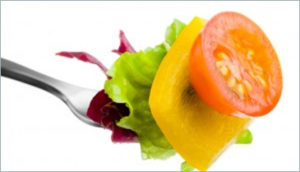We each own a secret weapon that weighs only a few ounces. If this was strategically deployed for one day, we could transform our world into a better place. We could end obesity and chronic disease, revitalize our children’s health, achieve academic excellence, topple corrupt governments, restore our depleted soils, replenish our vanishing aquifers and reverse climate change.
What is this weapon? It’s your fork.
It is more powerful than any other tool we can use to end most of the world’s problems.
How did we achieve civil and women’s rights? How did Gandhi liberate India? How did we end the Vietnam War? How did the Berlin Wall fall, bringing down with it the monolithic Soviet Union and its Iron Curtain? How did the Arab Spring topple despots in a few weeks?
Civil disobedience.
We just refused to accept things as they are; we collectively stood up to the oppression that weighed us down. Today, our bodies and our health are being held hostage by food terrorism. With every bite of industrial food, we contribute to the destruction of our health, our economy, and the environment.
That is why I want to create a grassroots civil disobedience movement around food.
Join the “Eat-In”
I call it a “global Eat-In“. You can join the movement by signing up for the first global Eat-In on April 7, 2013. Join me and thousands (maybe millions) of others as we cook and eat real food with family members and friends at home for just one day.
I will provide you with all the tools you need to joint the Eat-In. Stay tuned for more information in the next few weeks (Updated:Click here to join the Eat-In).
Imagine if, just for one day, we all chose to buy only fresh, whole, real, sustainably-raised or harvested food, food that heals both our body and our environment. If we only buy foods without labels, foods that come from nature, and avoid any food made or processed in a factory or altered from its original state.
Imagine if we cooked and ate all those meals at home with family and friends (or made them at home and brought them with us to work or school). Imagine if, suddenly, we didn’t buy the 1 billion Cokes consumed around the world everyday or add to the “billions served” at McDonald’s. Imagine if we could boycott the $1 trillion processed and fast food industry for just one day. Imagine what a ripple effect that would have.
It will take only one day to change everything. We only get what we accept. The crisis affecting us now is our greatest threat to freedom. But it is more subtle, more insidious.
It affects billions of people and robs our children of productive, healthy futures. It deprives us of “life, liberty and the pursuit of happiness”, the very foundation of our democracy.
And most of us quietly, hopelessly, endure, waiting for someone else to solve the problem. Henry David Thoreau said we “live lives of quiet desperation”. We think the problem is just too big. “How”, you may think, “Can I fight Big Food, Big Agriculture, Big Pharma, and the government policies that support them?”
But this is a very small problem. It is the size of your fork. It can be solved in your kitchen and by what you put on your fork. It is a very local problem, as local as your mouth.
Our most powerful tool to reverse the global epidemic of chronic disease, heal the environment, reform politics, and revive economies is the fork. What we put on it has tremendous implications, not just for our waistlines but also for the planet and our global economy. What we do to our bodies we do to the planet and what we do to the planet we do to our bodies.
How What We Eat Makes Us Sick and Harms the Environment
We are now suffering from an invisible epidemic of global sickness—162 million Americans have chronic diseases, 29 million people across the globe die each year from preventable lifestyle diseases (soon to be 50 million) killing twice as many as infectious disease. And 1.5 billion people are now overweight; almost double the number of those who are malnourished (870 million).(i) Eighty percent of the world’s type 2 diabetics are in the developing world.(ii)
The harm we do to our bodies is linked in a complex web to the harm we do to the planet, to the degradation of our environment, air, and water, and to the future we are stealing from our children. We are depleting nature’s capital and our human capital.
Nature’s capital, once destroyed, cannot be reclaimed. One acre of arable land is lost to development every minute of every day. Raising one pound of meat requires 2,000 gallons of water and produces 58 times more greenhouse gasses than 1 pound of potatoes. It takes 7,000 pounds of grain to feed the animals that produce 1,000 pounds of meat. Irrigation is depleting our Ogallala Aquifer on the Great Plains 1.3 trillion gallons faster than it can be replenished by rainfall.(iii)
Three quarters of our fresh water (only 5 percent of all the earth’s water) is used for agriculture, mostly to grow meat for human consumption. Water scarcity and the desertification of our agricultural lands are proceeding at a frightening pace.(iv)
But we have the power to change that. For example, if we all switched out one factory farmed meat meal for one vegetarian meal each week it would be the equivalent of taking half a million cars off the road.
Driving a Hummer and being a vegetarian produces less greenhouse gases than driving a Prius and eating factory farmed meat. Yet, when the USDA (United States Department of Agriculture) encouraged us to participate in “Meatless Mondays” the National Cattleman’s Beef Association lobbied the government to retract their recommendation. And they did.
The next time you pick up your fork, think of the personal and global impact of what you put on it.
I am not a vegetarian, but I would suggest that our modern cow is the 21st century equivalent of the atom bomb threatening our survival. A bold statement to be sure, but the cow is the nexus at which food, the health of the human species, and the heath of the planet, are inextricably linked.
When we bite down on a hamburger or T-bone steak, we think we are eating a cow. But we are not. Our modern cow has been transformed into a by-product of corn—and not just any corn—but a mountain of corn that has been genetically altered to be resistant to pesticides and herbicides and is grown in vast monocultures. This corn is high in sugar, starch, and health-destroying polyunsaturated fats.
It is “Frankencorn”, and it is hidden not only in the meat we eat but also in every processed food product in the country in the form of high fructose corn syrup. It blankets the nutritional landscape of America (and, increasingly, the world) driving the epidemics of obesity, heart disease, diabetes, and cancer.
Each year, ten billion bushels of corn are grown in America, most of which we don’t eat in a form we can recognize as corn. Sixty percent of our corn production is used to feed cows and other livestock.(v) It is also used to fuel our cars, it is the major ingredient in processed and fast food, and it is the major cause of obesity and diabetes. Biofuel gasoline, meat, and junk food alike are all by-products of corn.
The Native Americans gave corn to pilgrims so they could survive on this new continent, and now, ironically, it will be our demise.
But the problems with the cow don’t end there. The bulk of oil and fossil fuels we consume is not used to power the cars we drive. Instead, it is found in the foods we eat. One-fifth of the world‘s oil consumption is used for food production and transport. And it takes sixteen times more energy to produce six ounces of meat than to produce a cup of broccoli, a cup of eggplant, a cup of cauliflower, or a cup of rice.
Eating a meal of beef also produces 24 times more greenhouse gases than do carbon emissions because of the methane and nitric oxide produced by cow flatulence.(vi) Cows are ruminants meant to graze on grasses and the bacteria in their stomachs cannot digest grains (corn).
Grain simply sits in a cow’s stomach and ferments. The gas produced by the fermentation of corn in cows’ stomachs is one of the largest contributors to global warming.
Agriculture is responsible for an estimated 14 percent of the world’s greenhouse gases. A significant portion of these emissions come from methane, which, in terms of its contribution to global warming, is 23 times more powerful than carbon dioxide.
Cattle rearing generates more global warming greenhouse gases, as measured in CO2 equivalents, than does transportation.(vii)
So you see, what you put on your fork is more important than the car you drive, for both your health and the environment.
In my NEXT blog I will explain how to join the Eat-In and celebrate real whole, fresh, sustainably raised and grown food and help transform the future of food (Updated: Click here to join the Eat-In)!
Get started today! Get your copy of The Blood Sugar Solution Cookbooktoday. When you purchase this book from this link you will gain access to these exclusive bonuses:
- 1-Week Gluten-Free Meal Plan – Maps out a full week of breakfasts, lunches and dinners PLUS all new recipes for these.
- Access to my “In the Kitchen with Dr. Hyman” videos – Including cooking demos, fridge and pantry makeover, supermarket shopping tips, and more. Over 60 minutes of footage.
- You will be invited to a live online presentation hosted by me on March 27th, 2013.
Click here to learn more.
Please leave your thoughts by adding a comment below – but remember, we can’t offer personal medical advice online, so be sure to limit your comments to those about taking back our health!
To your good health,
Mark Hyman, MD
 by
by 



